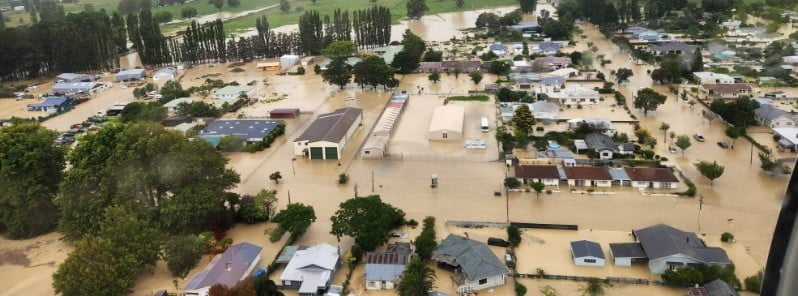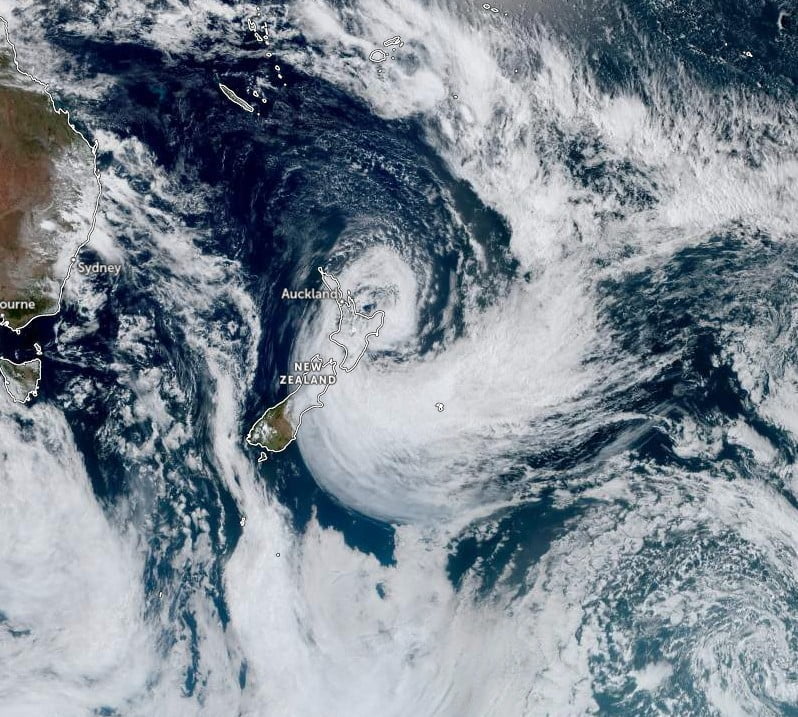National state of emergency declared as Cyclone Gabrielle causes widespread destruction across New Zealand’s North Island

New Zealand’s North Island has been severely impacted by Cyclone Gabrielle over the past couple of days, with floods, landslides, and ocean swells leaving many people stranded on rooftops. The storm, which caused extensive damage to homes and infrastructure, also closed numerous roads, canceled hundreds of flights, and left about 225 000 people without power. At least 11 people have been killed.
Cyclone Gabrielle was so severe that Prime Minister Chris Hipkins stated that the damage brought by the cyclone has not been experienced in a generation. The storm caused air pressure to drop to historically low levels around the North Island, with Whitianga station recording the 8th lowest daily minimum air pressure on record at 968.3 hPa on February 14. Gabrielle also caused a record storm surge of 0.7 m (2.3 feet) measured at the Whitianga monitoring station.
The storm produced significant rainfall in many regions, including the wettest February day on record in Whangārei and the second wettest February day on record in Napier on February 13. Auckland has already received over 55% of its annual normal rainfall in just 45 days.
From February 12 to 14, Raparapariki recorded 568 mm (22.4 inches) of rain. During the same period, Fernside recorded 375 mm (14.7 inches), Whangarei 345 mm (13.6 inches), Trounson 305 mm (12 inches), and Brynderwyn 299 mm (11.7 inches).
Wind gusts over 140 km/h (87 mph) have been recorded at many coastal locations, with urban areas also affected while wave heights close to 11 m (36 feet) were recorded off the coast of the Bay of Plenty.
The severe weather from Cyclone Gabrielle has continued throughout February 14, leading to widespread and significant impacts across the North Island.
Although today’s rain won’t be as persistent, river flows are extremely high and will continue to increase, particularly in the eastern North Island during the early afternoon high tide, NIWA said.
Emergency responders are urging people to evacuate beach settlements and leave their homes as rivers continue to rise, with large waves inundating beachfront properties. Many roads are closed, mobile phone services are down, and some towns have become isolated.
According to local media reports, a firefighter is missing after a house slid down a hill in Hawke’s Bay. Another significant landslide has occurred in Karekare, where five houses have been destroyed.
The storm has caused major disruptions to transport, with over 30 state highway closures and the shutdown of air, sea, and rail transport for much of the northern half of the North Island. Several communities and regions are isolated, and a National State of Emergency has been declared. Helicopters and boats are being used to rescue those trapped by the rapidly rising floodwaters in Hawke’s Bay.
Hawke’s Bay is still reeling from the impacts of Cyclone Gabrielle, as Civil Defence and lifeline services grapple to gain a full understanding of the situation with the failure of cellphone towers which has severely limited information flows.
The situation remains dynamic with new information still coming in and emergency services still undertaking foot patrols and rescues.
In Wairoa, the Wairoa River has burst its banks, inundating 10 – 15% of the town which is home to around half of the town’s 8 000 population. With no power or phones, the only communication is via satellite phone. There are very limited supplies of food and water with no drinking water supply due to the flooding.
The Mohaka Bridge on SH2 has been damaged, cutting off Wairoa from the south. With Tairawhiti – Gisborne heavily impacted by the cyclone the roads north are also impassable, isolating around 8 000 residents.
In CHB, the Waipawa and Tukituki Rivers have topped their banks, and there is a high probability of the stop bank failing with continued rainfall. The town water supply has failed due to flooding and the community is relying on its emergency supplies.
In Hastings and Napier, around 16 000 people are without power, and, because there is a serious Transpower grid issue, it says it could be days or weeks before power is returned to all customers.
The Ngaruroro River overtopped its banks, resulting in the evacuation of Ōmahu. Earlier in the day Taradale and parts of Meeanee were evacuated given the level of the Tutaekuri River, however, that alert was lifted at 16:00 LT today and reisdents were advised they could return home.
A number of bridges remain impassable, including Fernhill Bridge (Ōmahu), Vicarage Road (Puketapu), Waiohiki (Taradale) and Brookfields Bridge (Meeanee) and the Esk Bridge north of the SH2 intersection with SH5.
Waka Kotahi has closed the bridges on SH2 due to safety concerns. Combined with roads being blocked due to flooding and trees, Napier and Hastings are now isolated from each other. The Hastings and Napier drinking water supplies remain operational but the community is asked to restrict their use to reduce the impact on the wastewater network.
Eskdale Valley has been particularly hard hit by the cyclone, with extensive damage. In addition to evacuation orders and self-evacuations, a number of rescues have been undertaken by emergency services.


Hawke’s Bay has reported a fatality in the region following the death of a woman in Putorino after a bank collapsed onto her home. Police visited the property following a missing person’s report and undertook rescue efforts but were unsuccessful.
HB Civil Defence has requested support from the National Emergency Management Agency, with the scale of damage to infrastructure beyond the capacity of the region to manage.
Hawke’s Bay Civil Defence Controller Iain Maxwell said the impact of this cyclone was yet to be fully understood and it is going to take some for all of the impacts to be remedied.
Though the rain was forecasted to ease in the upper North Island on February 14th, it was expected to continue in Tairāwhiti/Gisborne and northern Hawke’s Bay until the night, with rain also affecting the lower North Island and parts of Marlborough.
Gabrielle is expected to take a southeast track moving away from New Zealand from early February 15, but the impacts from this event are likely to be felt for much longer.
This extreme weather event comes just 2 weeks after North Island experienced extreme rainfall and widespread flooding and destruction in which 4 people lost their lives.
In late January, Auckland experienced extreme rainfall and severe flooding that rendered thousands of buildings in the region uninhabitable. The Auckland area recorded its wettest month in at least 170 years, with the Auckland Airport receiving 245 mm (9.65 inches) of rain in a day, surpassing the previous daily record by over 50%.
Other weather stations around the region also reported remarkable rainfall, with many spots noting between 250 – 300 mm (9.84 – 11.81 inches) of rain within the day. Some stations even reported over 80 mm (3.15 inches) of rain in an hour.
To put this into context, the highest classification for intense rain at New Zealand’s MetService is ‘torrential’, which is defined as 40 mm (1.57 inches) of rain or more in an hour.
The flooding has put the public’s focus on nature-based alternatives to traditional stormwater systems, according to NIWA Urban Aquatic Scientist Dr. Annette Semadeni-Davies.
Updates
15:30 UTC, February 15
The number of fatalities has increased to 4 while more than 1 400 individuals have been reported as uncontactable, across Hawke’s Bay, Tairawhiti, and other parts of the North Island. This high number of unaccounted people is most likely due to severed communication lines.
More than 9 000 people have been displaced, of which 3 000 were accommodated in temporary shelters. Power outages have been reported for around 160 000 customers across North Island.
06:32 UTC, February 19
The death toll has risen to 11.
Prime Minister Chris Hipkins said 6 431 people remain missing, while 3 216 had been found safe.
References:
1 Cyclone Gabrielle still impacting some areas, easing by the end of today – MetService – February 14, 2023
2 Situation update by Hawke’s Bay Emergency Management – February 14, 2023
3 Cyclone Gabrielle – Extreme rain and winds impact New Zealand, unprecedented rainfall totals expected in some areas – The Watchers – February 12, 2023
Featured image credit: Hawke’s Bay Emergency Management




Commenting rules and guidelines
We value the thoughts and opinions of our readers and welcome healthy discussions on our website. In order to maintain a respectful and positive community, we ask that all commenters follow these rules.